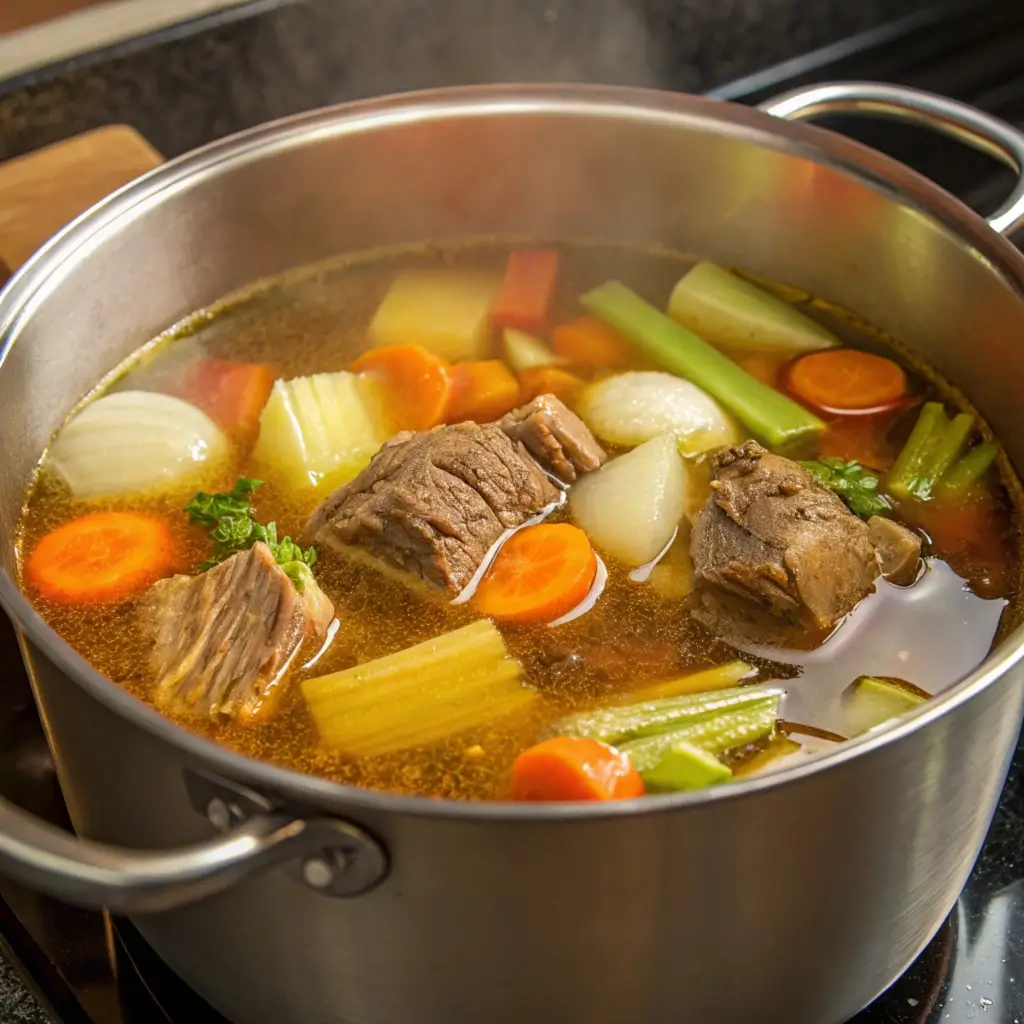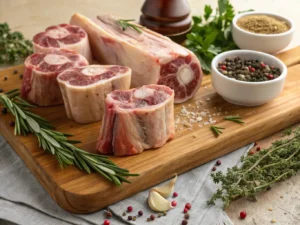Beef bones are a hidden gem in the culinary world, packed with flavor and nutrients that add depth to countless recipes. From creating rich broths to crafting mouthwatering dishes like Osso Buco or pho, these bones are a cornerstone of traditional and modern cooking alike. But what are beef bones called, and how can you distinguish between the various types?
In this article, we’ll dive into the fascinating world of beef bones, exploring their types, uses, nutritional benefits, and much more. Whether you’re a culinary enthusiast or just curious about what makes your favorite soups and stews so flavorful, this guide will provide the answers you need.
Introduction to Beef Bones
What Are Beef Bones?
Beef bones, quite simply, are the skeletal remains of cattle used for culinary and nutritional purposes. They come in a variety of types, each serving a unique function in cooking. These bones are often categorized by their location in the animal, such as marrow bones, knuckle bones, or neck bones.
The most popular beef bones are those that pack a punch in terms of flavor and richness. For instance, marrow bones are prized for the buttery texture and taste of their marrow, while shank bones are celebrated for their ability to create silky broths. It’s no wonder chefs and home cooks alike rave about the versatility of these ingredients!
Importance of Beef Bones in Cooking
Why do so many cuisines around the world feature beef bones? The answer lies in their unmatched ability to enhance both flavor and texture. Beef bones are the secret weapon behind the gelatinous, nutrient-packed stock that forms the base of countless dishes.
They also boast impressive nutritional benefits, offering collagen, minerals, and essential amino acids. Not only do these elements support joint health and skin elasticity, but they also help craft dishes that are as nourishing as they are delicious.
Marrow Bones
Description and Characteristics
Marrow bones are typically large, thick bones like the femur or shank, containing rich, fatty marrow at their center. This marrow is prized for its buttery texture and deep flavor. When roasted, the marrow becomes soft and spreadable, making it a delicacy in many cuisines.
These are prized for their creamy, rich marrow that’s extracted during cooking. Perfect for broths or spreading on toast for an indulgent treat. Explore more in the Understanding the Different Types of Beef Bones and Their Culinary Uses.
Culinary Uses
Marrow bones are versatile in the kitchen. They’re often roasted and served with toast as a gourmet appetizer. Additionally, the extracted marrow can enrich sauces, providing a luxurious mouthfeel. Incorporating marrow bones into broths or soups imparts a rich, beefy flavor and adds nutritional value.
Knuckle Bones
Description and Characteristics
Knuckle bones come from the joints and are rich in cartilage and connective tissue. These components break down during cooking, releasing gelatin that contributes to a broth’s body and texture. Knuckle bones are typically irregular in shape and contain little to no marrow.
Ideal for creating gelatinous stocks, knuckle bones are commonly used in soups like pho. Check out how they enhance recipes in our Beef Bones: The Ultimate Guide to Their Uses and Benefits.
Culinary Uses
Due to their high collagen content, knuckle bones are ideal for making gelatinous broths and stocks. They’re commonly used in traditional dishes like pho, where a clear, flavorful broth is essential. Slow-cooking knuckle bones helps extract maximum flavor and nutrients, resulting in a hearty base for soups and stews.
Beef bones are a kitchen staple for enhancing flavors and adding richness to dishes. Whether making a simple stock or a gourmet beef broth, these bones bring complexity to every bite. For a quick and easy brisket recipe using beef bone stock, check out our Fast Beef Brisket Recipe: A Quick and Delicious Guide.
Neck Bones
Description and Characteristics
Neck bones are meaty sections from the animal’s neck, containing small bones surrounded by muscle and connective tissue. They offer a balance of meat and bone, providing both flavor and substance to dishes. The meat is flavorful but requires slow cooking to become tender.
Culinary Uses
Neck bones are excellent for braising and stewing. When simmered slowly, the meat becomes tender, and the bones release flavors that enhance the dish. They’re often used in hearty soups and stews, contributing both meat and depth of flavor.
Oxtail
Description and Characteristics
Oxtail refers to the tail of the cattle, comprising a series of small, bony segments with a substantial amount of connective tissue and marrow. The high collagen content in oxtail results in a rich, gelatinous broth when cooked. The meat is flavorful but requires long, slow cooking to become tender.
Culinary Uses
Oxtail is a star ingredient in many traditional dishes worldwide. It’s commonly used in oxtail soup, where slow cooking transforms it into a tender, flavorful delight. The gelatin released during cooking adds a luxurious texture to the broth, making it a favorite in comfort food recipes.
Specialized Beef Bones and Their Applications
Beyond the common types, several specialized beef bones offer unique flavors and textures, enhancing various culinary creations.
Shank Bones
Description and Characteristics
Shank bones are cut from the leg portion of the cattle and include both bone and surrounding meat. They are known for their rich marrow and connective tissues, which break down during cooking to produce a silky, flavorful broth. The meat is lean and requires slow cooking to become tender.
Culinary Uses
Shank bones are essential in dishes like Osso Buco, a classic Italian braised veal shank recipe. The combination of marrow, meat, and bone enriches the dish with deep flavors and a velvety texture. They’re also excellent for making hearty stews and soups, where the slow-cooked meat adds substance and the marrow enhances the broth’s richness.
Rib Bones
Description and Characteristics
Rib bones come from the rib section of the cattle and are often associated with prime cuts of meat. They contain a good amount of marrow and are surrounded by flavorful meat. Rib bones are typically curved and can vary in size depending on the specific cut.
Culinary Uses
Rib bones are popular in barbecue and grilling recipes. The meat around the bones is tender and flavorful, making them ideal for dishes like beef ribs. When slow-cooked or smoked, the marrow and connective tissues break down, infusing the meat with rich flavors. Rib bones are also used to enhance stocks and broths, adding depth and complexity to the flavor profile.
Femur Bones
Description and Characteristics
Femur bones are the large thigh bones of cattle, known for their substantial marrow content. They are dense and robust, containing a significant amount of marrow that is highly valued for its rich, buttery flavor. Femur bones are typically long and straight, making them suitable for roasting.
Culinary Uses
Femur bones are often roasted to extract the marrow, which can be spread on toast or used to enrich sauces and soups. The roasted bones themselves can be added to stocks to impart a deep, beefy flavor. Additionally, the marrow from femur bones is used in gourmet dishes to add a luxurious element, enhancing both flavor and texture.
Nutritional Benefits of Beef Bones
Beef bones are more than just flavor enhancers; they’re packed with nutrients that offer various health benefits. Understanding what beef bones are called can help you select the right type to maximize these benefits.
Collagen and Gelatin Content
Beef bones, especially knuckle and marrow bones, are rich in collagen. When simmered, collagen transforms into gelatin, a substance that supports joint health and aids digestion. Gelatin contains amino acids like glycine and proline, which are essential for maintaining healthy skin, hair, and nails. Additionally, gelatin can help improve gut integrity by strengthening the lining of the digestive tract, potentially reducing issues like leaky gut syndrome.
Mineral Composition
Simmering beef bones releases essential minerals into the broth, including calcium, magnesium, phosphorus, and trace amounts of other nutrients. These minerals are vital for bone health, muscle function, and overall metabolic processes. For instance, calcium and phosphorus work together to maintain strong bones and teeth, while magnesium plays a role in muscle contractions and nerve signaling. Incorporating bone broth into your diet can help supplement these minerals, especially if your regular intake is insufficient.
For more delicious recipes that incorporate beef bones, check out our recipe article.
Selecting and Preparing Beef Bones for Cooking
Choosing the right beef bones and preparing them properly is crucial for culinary success. Here’s how to do it:
Choosing Quality Beef Bones
When selecting beef bones, consider the type based on your cooking needs. Marrow bones are ideal for rich broths, while knuckle bones are excellent for stocks due to their high collagen content. Always opt for bones from grass-fed, organically raised cattle to ensure higher nutrient quality and better flavor. Freshness is key; look for bones that are free from discoloration and have a clean, meaty smell.
Preparation Techniques

Before cooking, it’s essential to prepare the bones properly. Rinse them under cold water to remove any residual blood or bone fragments. For enhanced flavor, especially in broths and stocks, roast the bones in the oven at 400°F (200°C) for about 30 minutes until they’re browned. This caramelization adds depth to your dishes. After roasting, place the bones in a stockpot, cover with cold water, and bring to a gentle simmer. Skim off any foam that rises to the surface to keep the broth clear. Adding vegetables like onions, carrots, and celery, along with herbs and spices, can further enhance the flavor.
For more delicious recipes that incorporate beef bones, check out our recipe article.
Popular Dishes Featuring Beef Bones
Beef bones are a cornerstone of many traditional dishes worldwide. Their unique flavors and textures elevate recipes, transforming simple ingredients into extraordinary meals. But first, what are beef bones called in various culinary contexts? Depending on the recipe, they might be referred to as marrow bones, knuckle bones, or oxtail, among others. Let’s explore some iconic dishes where beef bones shine.
Bone Broth and Stock
Bone broth and stock are staples in countless kitchens. These nutrient-rich liquids are made by simmering beef bones—such as marrow, knuckle, or shank bones—with water, vegetables, and herbs. The result is a flavorful base for soups, stews, and sauces. Bone broth, in particular, is prized for its health benefits, thanks to the collagen and gelatin extracted during the slow cooking process.
Osso Buco
This classic Italian dish features braised veal or beef shanks with bone marrow at its center. The shank bones release marrow and collagen during cooking, creating a sauce that’s rich, silky, and full of flavor. Osso Buco is traditionally served with gremolata and a side of risotto or polenta, making it a comforting yet elegant meal.
Pho
A beloved Vietnamese soup, pho relies heavily on beef bones for its signature broth. A mix of marrow bones, knuckle bones, and oxtail is simmered with spices like star anise, cloves, and cinnamon. The result is a clear, aromatic broth that serves as the foundation for this iconic dish, complemented by rice noodles, fresh herbs, and tender beef slices.
Korean Gomtang
Gomtang is a hearty Korean soup made by simmering beef bones—often shank or knuckle bones—over low heat for several hours. The extended cooking process extracts nutrients and flavor, resulting in a milky-white broth. Served with rice and seasoned with salt, gomtang is both nourishing and comforting.
Frequently Asked Questions (FAQs) About Beef Bones
What are beef soup bones?
Beef soup bones, also known as marrow or knuckle bones, are used to make broths and stocks. They’re often sold in butcher shops or grocery stores and contain marrow, connective tissue, and sometimes meat, making them perfect for creating flavorful, nutrient-rich bases for various dishes.
Can you eat the marrow from beef bones?
Yes, you can! Marrow is not only edible but also highly nutritious and flavorful. After roasting beef bones, the marrow can be scooped out and spread on bread or added to soups and stews for extra richness.
How long should you simmer beef bones for broth?
To extract maximum flavor and nutrients, beef bones should be simmered for at least 12–24 hours. This slow cooking process ensures that the collagen, gelatin, and minerals are fully released into the broth.
Where can I buy high-quality beef bones?
High-quality beef bones can be found at local butcher shops, farmers’ markets, or specialty grocery stores. Look for bones from grass-fed, organic cattle to ensure better flavor and nutritional value.
Beef Bone Broth
Equipment
- Large Stockpot or Slow Cooker
- Baking Sheet
- Strainer
- Ladle
- Glass Storage Jars
Ingredients
Beef Bones
- 3 lbs beef marrow bones (or a mix of knuckle, neck, and shank bones)
- 2 tbsp apple cider vinegar helps extract minerals
Vegetables and Aromatics
- 2 large carrots chopped
- 2 stalks celery chopped
- 1 large onion quartered
- 4 cloves garlic smashed
- 2 tsp salt adjust to taste
- 1 tsp black peppercorns
- 2 leaves bay leaves
- 10 cups water or enough to cover bones
Instructions
- Preheat oven to 400°F (200°C). Place the beef bones on a baking sheet and roast for 30 minutes, turning once halfway through. This enhances the flavor of the broth.
- Transfer roasted bones to a large stockpot or slow cooker. Add apple cider vinegar and let sit for 20 minutes to help extract minerals.
- Add carrots, celery, onion, garlic, salt, peppercorns, bay leaves, and enough water to fully cover the bones.
- Bring to a gentle simmer over medium heat. Reduce heat to low and simmer uncovered for at least 12–24 hours. Skim off any foam that rises to the surface.
- After cooking, strain the broth through a fine-mesh strainer or cheesecloth into glass jars.
- Let broth cool, then refrigerate. A layer of fat will form on top—skim this off if desired before using.
Notes
Conclusion

Beef bones are an unsung hero in the culinary world, providing rich flavors, health benefits, and a touch of tradition to countless dishes. But for those wondering, what are beef bones called? The answer varies depending on their type and purpose—marrow bones, knuckle bones, shank bones, oxtail, and more. Understanding their unique properties can elevate your cooking to new heights.
In this article, we explored the common types of beef bones and their specialized uses, from making nutrient-packed broths to creating iconic dishes like pho and Osso Buco. We also discussed their nutritional value, preparation techniques, and where to find high-quality options. Whether you’re simmering bones for hours to create a rich stock or roasting them to enjoy the buttery marrow, these versatile ingredients never disappoint.
So, the next time you’re planning a hearty soup or a gourmet meal, don’t overlook beef bones. Their ability to transform simple recipes into unforgettable culinary experiences makes them a must-have in any kitchen. Give them a try—you’ll not only add depth to your cooking but also embrace a time-tested tradition that connects us to the heart of homemade meals.
Call to Explore More (Optional Addition)
For those interested in diving deeper into the world of cooking with beef bones, be sure to check out other inspiring recipes and guides on Spedy Recipes. Whether you’re a seasoned chef or a home cook, you’ll find creative ways to use these incredible ingredients and make the most of their flavors and benefits. Happy cooking!
- Tropical Pineapple Salsa -Fresh, Flavorful, and Easy to Make
- Homemade Salsa for Canning – Honeybunch Hunts
- Easy Homemade Salsa Verde | Complete Guide
- Black Bean Corn Salsa – Fresh and Flavorful Recipe
- Pineapple Salsa That Wows at Every Party

